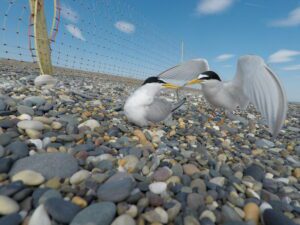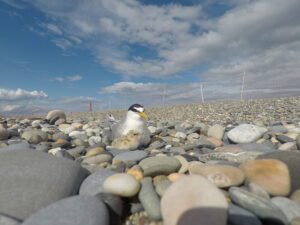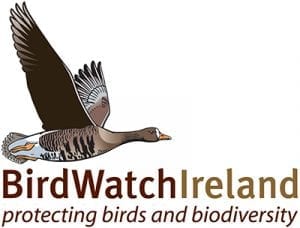There is no doubt that turning the tide against biodiversity loss is an uphill battle but despite the worrying trends for many species, there is proof out there that we can halt and reverse declines. Indeed, well-resourced, science-based and longstanding conservation projects truly work, and the Kilcoole Little Tern Project is a shining example of this. It is a National Parks and Wildlife Service (NPWS) project, run by BirdWatch Ireland to date.
Of course, every season comes with surprises and 2024 was no exception. There is usually some predictability around the dates the Little Terns arrive back from Africa, and we aim to have the colony fencing and hide in place by the time the first eggs are being laid. The Terns had other plans this year though.
“The season kicked off surprisingly early. The first egg was discovered on the 9th of May. Usually, the 14th or 15th would be considered early so we were caught off guard, in a positive way. We were still in set-up mode at that stage,” explains Brian Burke, Coordinator of the Kilcoole Little Tern Project.
“When that happens, you have to be careful when setting up the fencing to not cause disturbance. We had to tailor what we were doing to ensure that we didn’t keep them off the nests for too long. Thankfully, everything went smoothly and chicks from all of those early nests hatched successfully.”
It is difficult to pinpoint why some terns arrive early. However, it is likely influenced at least in part by the Kilcoole project itself.
“Kilcoole is a reliable and successful place for them to nest, not because there is anything particularly unique about the beach, but because of the project and the level of protection it has provided to the birds for many years,” says Brian. “The most experienced terns always start nesting first and, the more experienced terns you’ve had, the earlier the season begins.”
As the rate of new eggs being laid continued apace, it was quickly becoming clear that a very large number of Little Terns had returned to Kilcoole this year.
At its peak in early June we recorded over 270 nesting pairs of Little Terns at Kilcoole. This is the highest-ever number for the project and a long way from the 14 pairs recorded at the project’s onset many years ago. Based on these figures, Kilcoole likely had one of the largest Little Tern colonies in the Ireland and Britain this year and numbers from colonies monitored and protected by Louth Nature Trust at Baltray, BirdWatch Ireland Fingal Branch in Portrane, and NPWS in Cahore all suggest healthy nesting numbers at other key Irish sites.
The 2024 season wasn’t all plain sailing, however.
“We had one week in June where the birds’ fortunes took a hit, unfortunately. There was some predation by Hooded Crows, who caused a lot of damage in a short space of time before the wardens could put a stop to it. A few days later, stormy weather and a sea swell at high tide took a lot of medium-sized chicks on the shoreline,” says Brian.
“If these impacts happened earlier in the season when most were still on their eggs, there would have been the time and opportunity for birds to relay. Unfortunately, because of the timing in mid-June, many of the birds were too late to try again. That was the low point of the season and the hard-hitting reality of this kind of work.”
Thankfully, things have been progressing very well since. Any subsequent predation incidents were minor and successfully managed by the colony wardens and a large number of chicks have now fledged. Some of them have already been spotted at the Little Tern conservation project at Portrane in north Dublin, and Gronant in Wales, as they explore the Irish Sea prior to migration.
The colony has also managed to escape Avian Influenza (Bird Flu) for another year. While the nesting habits of Little Terns make them less vulnerable to Avian Flu than those that nest in mixed species, high-density colonies such as Common Terns and Roseate Terns, the potential threat of the deadly disease is never far from our minds during the breeding season.
Most of the Kilcoole Little Terns have now left the site and the few remain will soon depart, leaving Brian and the wardens behind with reports to write and reflections on another busy season!
“The lesson this year is that every year is different. We are constantly trying to control what we can control but of course, some things are uncontrollable. Overall, it’s about us giving the birds more good years than bad years,” says Brian.
[Nesting Little Tern Photos by Brian Burke, taken under NPWS licence]
The Kilcoole Little Tern Project is an NPWS project run by BirdWatch Ireland under a competitive tender agreement in 2024.









